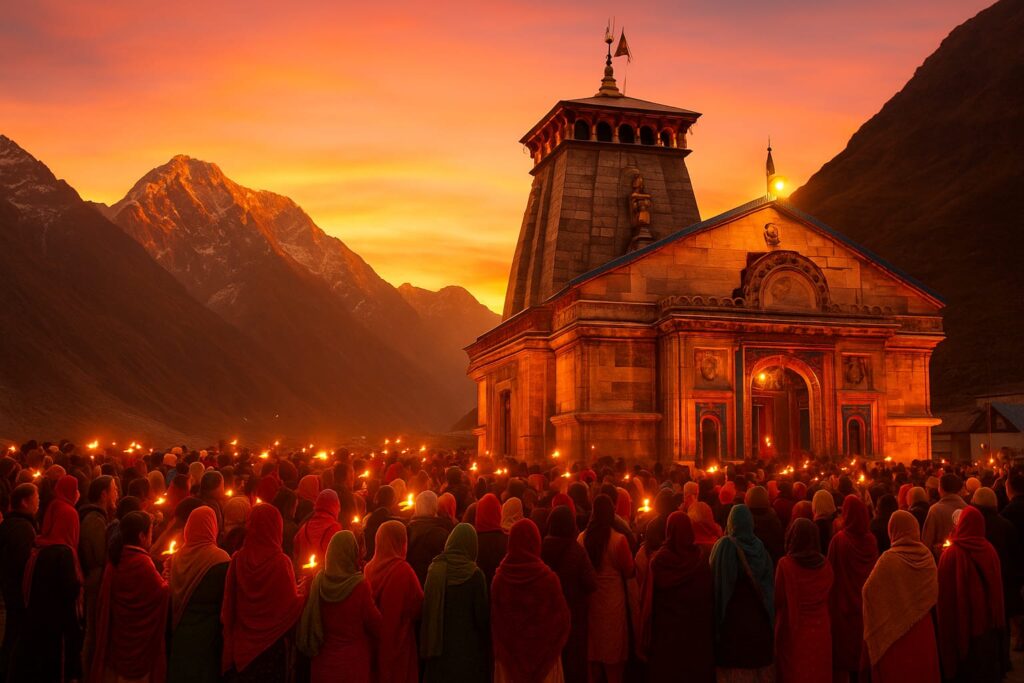Panch Kedar Yatra – A Complete Guide
The Panch Kedar Yatra in Uttarakhand is one of the most divine pilgrimages dedicated to Lord Shiva. Nestled in the majestic Garhwal Himalayas, the Panch Kedar temples—Kedarnath, Tungnath, Rudranath, Madhyamaheshwar, and Kalpeshwar—are believed to be built by the Pandavas to seek forgiveness from Lord Shiva after the Kurukshetra war.
According to legend, Lord Shiva, avoiding the Pandavas, disguised himself as a bull and dived into the ground. Different parts of his body appeared in different places, forming the sacred Panch Kedar shrines.
Embarking on the Panch Kedar Yatra is not just a pilgrimage, but also a journey through mystical valleys, snow-clad mountains, serene meadows, and spiritual awakening.
️ 1. Kedarnath – The Supreme Among Panch Kedar
Location: Rudraprayag District, Uttarakhand
Importance: Kedarnath is the most prominent temple among Panch Kedar and also one of the Char Dham shrines. The hump of Lord Shiva appeared here.
️ Highlights:
One of the 12 Jyotirlingas of Lord Shiva.
Located at an altitude of 3,583 meters, surrounded by snow peaks.
Trekking route: 16 km from Gaurikund.
Why Visit: Spiritual center of Shaivism, breathtaking Himalayan views, and deep religious significance.

2. Tungnath – The Highest Shiva Temple in the World
Location: Rudraprayag District, Uttarakhand
Importance: The arms of Lord Shiva appeared here.
️ Highlights:
Situated at 3,680 meters, Tungnath is the highest Shiva temple in the world.
Famous trekking route (3.5 km) from Chopta, known as the “Mini Switzerland of Uttarakhand.”
Gateway to the famous Chandrashila Peak trek.
Why Visit: A blend of divinity and adventure, offering 360° views of Himalayan peaks like Nanda Devi, Chaukhamba, and Trishul.
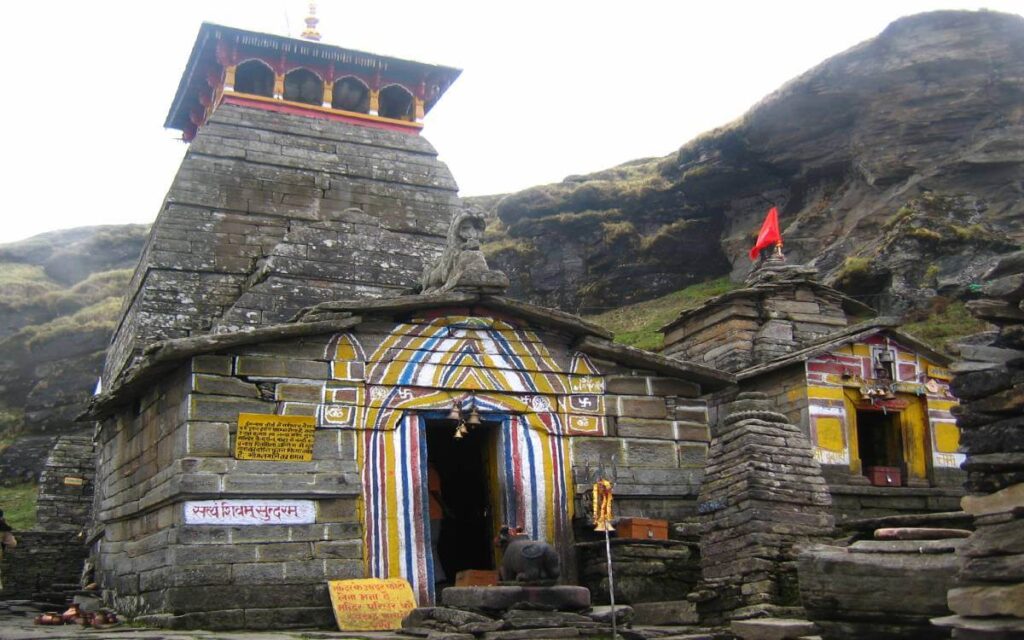
3. Rudranath – The Face of Lord Shiva
Location: Chamoli District, Uttarakhand
Importance: The face (mukha) of Lord Shiva appeared here.
️ Highlights:
Surrounded by dense forests and alpine meadows.
The trek passes through enchanting villages, bugyals (meadows), and glaciers.
Offers spiritual peace in solitude away from crowded shrines.
Why Visit: A remote and mystical temple where devotion meets serenity. Perfect for those seeking peace in the lap of nature.
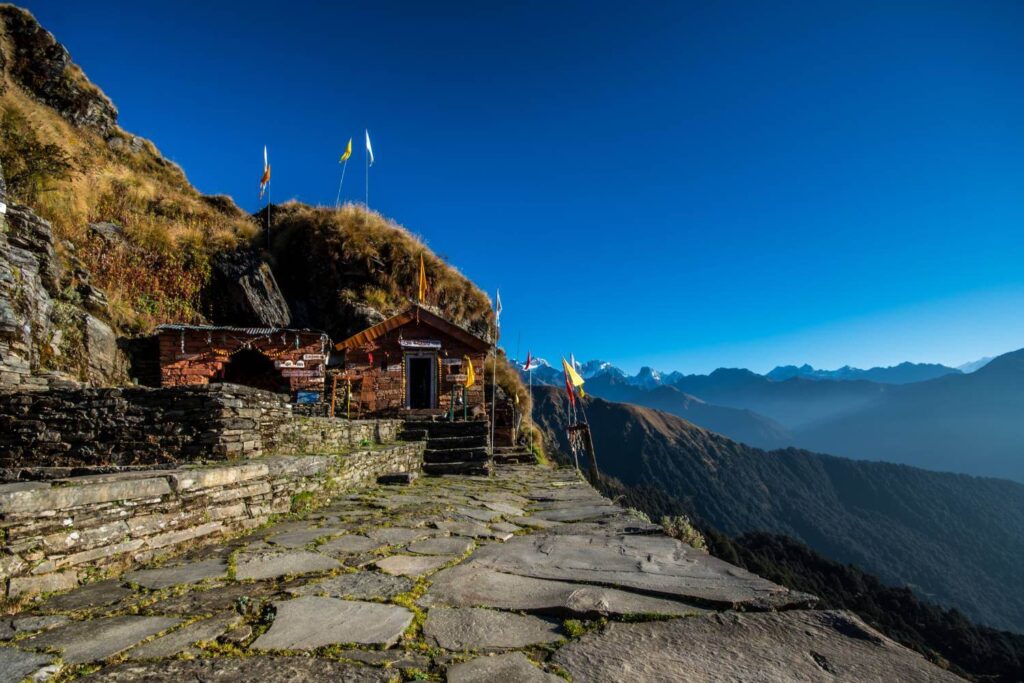
4. Madhyamaheshwar – The Navel of Lord Shiva
Location: Rudraprayag District, Uttarakhand
Importance: The navel (stomach) of Lord Shiva appeared here.
️ Highlights:
Perched at 3,497 meters, surrounded by lush meadows and snow-capped mountains.
Famous for its breathtaking view of Chaukhamba peaks reflecting in a crystal-clear pond near the temple.
A moderate trek of around 16–18 km from Uniana village.
Why Visit: A rare mix of divine energy, untouched natural beauty, and panoramic Himalayan landscapes.
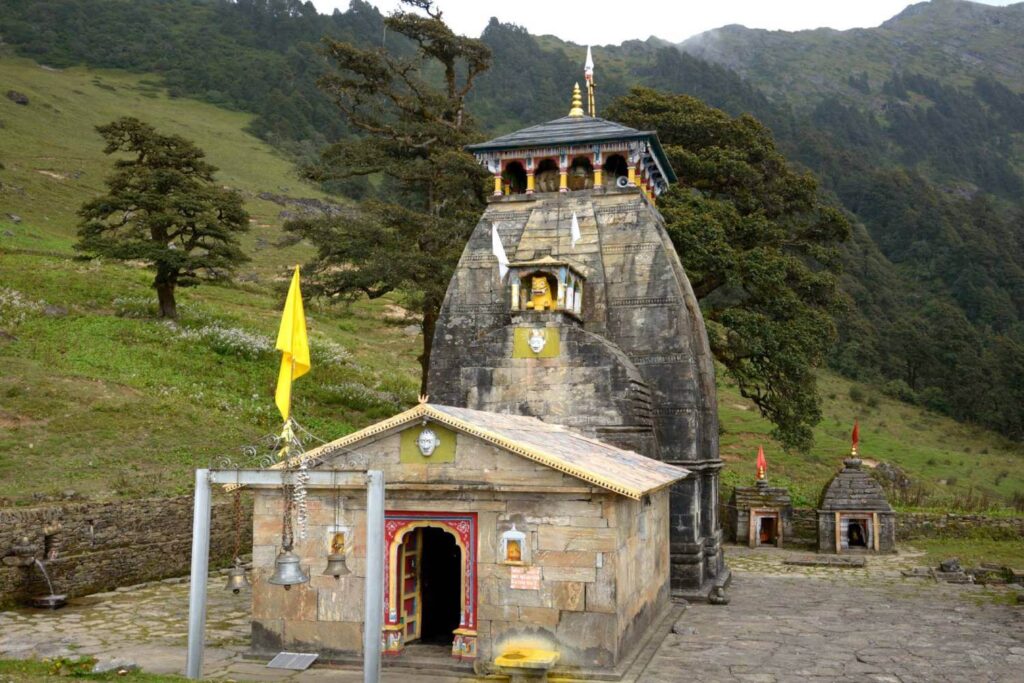
5. Kalpeshwar – The Locks of Lord Shiva
Location: Urgam Valley, Chamoli District, Uttarakhand
Importance: The matted hair (jata) of Lord Shiva appeared here.
️ Highlights:
The only Panch Kedar temple open throughout the year.
Located at a relatively lower altitude (2,200 meters).
Surrounded by apple orchards, waterfalls, and thick forests.
Trek of about 10 km from Helang on the Rishikesh–Badrinath road.
Why Visit: The easiest Panch Kedar temple to access, making it perfect for senior citizens and those seeking blessings year-round.
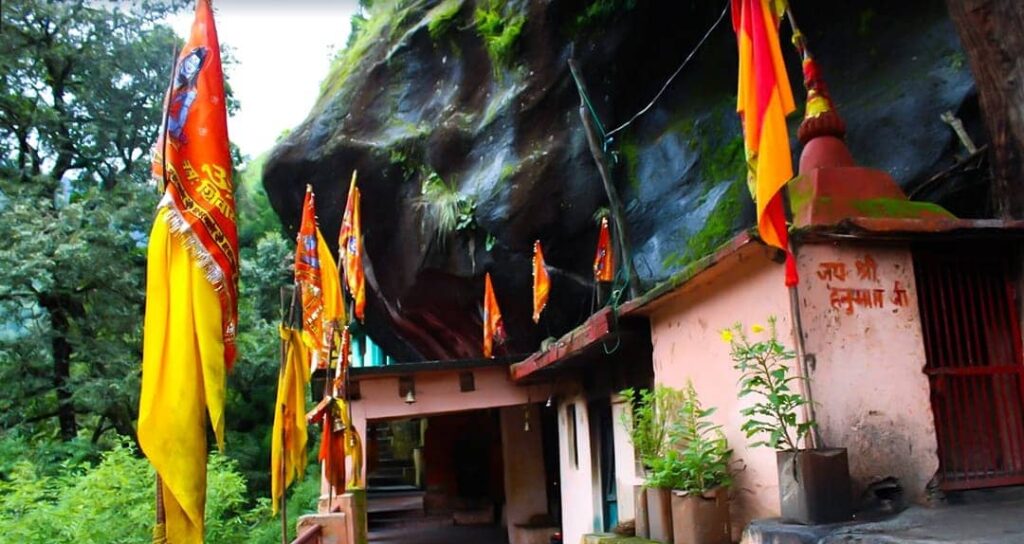
Mythological Connection of Panch Kedar
According to the Mahabharata, after the Kurukshetra war, the Pandavas wanted to atone for their sins of killing their own kin. Lord Shiva, unwilling to forgive them easily, disguised as a bull. Bhima recognized him and tried to catch him, but Shiva vanished into the ground. Different parts of his body appeared at five places, which are now worshipped as Panch Kedar.
Hump → Kedarnath
Arms → Tungnath
Face → Rudranath
Navel → Madhyamaheshwar
Hair → Kalpeshwar
Best Time for Panch Kedar Yatra
May to October is the ideal time (summer & post-monsoon).
Temples remain closed in winter (November–April) due to heavy snowfall, except Kalpeshwar which is open year-round.
How to Plan Panch Kedar Yatra
Start from Rishikesh or Haridwar.
Visit in the sequence: Kedarnath → Tungnath → Rudranath → Madhyamaheshwar → Kalpeshwar.
Travel can be done by road + trekking. Helicopter services are available for Kedarnath.
Conclusion
The Panch Kedar Yatra is not just a pilgrimage but a journey of faith, adventure, and devotion. From the mighty Kedarnath to the peaceful Kalpeshwar, every temple offers a unique divine experience. With snow-capped mountains, sacred legends, and spiritual vibrations, the Panch Kedar circuit is truly a once-in-a-lifetime journey for every devotee of Lord Shiva.
Panch Kedar Yatra
Panch Kedar is a group of five Hindu temples located in the state of Uttarakhand in northern India. These temples are dedicated to Lord Shiva and are considered among the holiest pilgrimage sites in India. The five temples that make up Panch Kedar are Kedarnath, Tungnath, Rudranath, Madmaheshwar, and Kalpeshwar.
Kedarnath is the most famous temple among the five and is located at an altitude of 3,583 meters (11,755 feet) in the Himalayas. Tungnath is the highest temple of Lord Shiva and is located at an altitude of 3,680 meters (12,073 feet). Rudranath, Madmaheshwar, and Kalpeshwar are also located in remote areas of the Himalayas and are visited by devotees during the pilgrimage season.
Panch Kedar yatra is a popular pilgrimage circuit among Hindus and is undertaken by thousands of devotees every year. The pilgrimage season usually starts in May and lasts until November, and the trek to these temples can be challenging and requires a certain level of physical fitness.
Major Sightseeing: –
- Devparyag (sangam/confluence)
- Rudraparyag (sangam/confluence)
- Omkareshwar Temple Ukhimath.
- Ardhnareshwar temple & Manikarkund Temple.
PANCH KEDAR TOUR ITINERARY

Day 01: Haridwar – Guptkashi
Your panch kedar yatra is going to start from haridwar railway station. It will go to guptkashsi first.You’ll gonna see first, the great and famous temple of Kali maiyaan “DharaDevi temple” enroute which is in the middle of alaknanda river at kalyasour at the route of Srinagar. The destinations,Guptkashi,Vishwanath temple, Ardhnareshwar temple & Manikarkund where the two streams of river ganga
and yamuna are believed to meet. Check in to the hotel. Overnightstay at hotel.
Day 02: Guptkashi –Sersi/Phata-Sonprayag
After breakfast check out from hotel, then drop to Sonprayag (for trek route) trek starts from here to Kedarnath Ji. Start to ascend on trek route either by walk or pony/doli (at own cost). Helicopter service is also available for Kedarnath, so one can take helicopter to Kedarnath (at own cost). Tour members should carry personal medicines, heavy woolen, toiletries and clothes. After performing Pooja & Darshan of Shri Kedarnath Ji. Overnight stay at GMVN Dormitory at Kedarnath.
Day 03: Kedarnath – Sonprayag-Sersi/Phata
Morning Kedarnath Ji Darshan then move by walk trek 16Km down reach Sonparyag, then our Vehicle pick up you at Sonparyag, and then drive to Sersi/Phata, check in to the hotel. Overnight stay at hotel.
Day 04: Sersi/Phata- Ransi Village
After breakfast check out from hotel, then drive to the hotel to Ransi Village, en route you can see Ukhimath Omkareshwar Mandir,then drive to Ransi Village. Check in to the hotel rest and relaxes at hotel. Ransi Village starting point of Madmaheshwar Trek.
Day 05: Trek to Nanu via Gaundar
Ransi village is the starting point of Madmaheshwar Trek. So you have to wake up early in the morning and breakfast is ready to eat. after breakfast, you have to trek for Nanu via Gondar. The beauty of the area while your trekking made you speechless. After reaching to Gaundar you can have your dinner and take rest on your Tents / Homestay.Overnight stay at Tents / Homestay at Nanu.
Day 06: Trek to Madmaheshwar Temple
After morning breakfast check out from Tent/Homestay, and then trek to Madmaheshwar, on this trek you explore Buda Madmaheshwar. Dinner at Madmaheshwar and overnight stay at Tents/Homestay at Madmaheshwar.
Day 07: Trek down to Ransi Village – Chopta
After morning breakfast check out from Tent/Homestay and then trek down to Ransi Village (18K.M.) and after reaching Ransi Village you have Drive to Duggalbita Chopta. Dinner at Chpota and overnight stay at hotel.
Day 08: Chopta to Sagar Village (Trek to Tungnath-Chandrashila)
After morning breakfast check out from Hotel, and then trek Tungnath and beyond to Charndrashila. After reaching the Temple take some blessing from God and trek back to chopta and drive to Sagar Village. Dinner at Sagar Village and overnight stay at Hotel.
Day 09: Trek to Panar Bugyal
After morning breakfast check out from Hotel, and then trek from Sagar Village to panar Bugyal which is almost 12 k.m. Dinner at Panar Bugyal and overnight stay at Tent/Homstay in Panar Bugyal.
Day 10: Panar Bugyal to Rudranath
After morning breakfast trek from Panar Bugyal to Rudranath Temple. After reaching Rudranath Temple take some blessing from God and the enjoy the environment and surroundings of the Temple or beautiful nature view of the area and return to Panar Bugyal. Dinner at Panar Bugyal and overnight stay at Tent/Homstay in Panar Bugyal.
Day 11: Panar Bugyal to Sagar Village – Helang
After morning breakfast check out from Tent/Homstay, and then trek down from Panar Bugyal to Sagar Village. After reaching Sagar village then drive to Helang. Dinner at Helang and overnight stay at Hotel.
Day 12: Helang to Kalpeshwar – Rudraprayag
After morning breakfast check out from Hotel and then drive to Kalpeshwar. After reaching Kalpeshwar (01km.trek) take some blessing God of Kalpeshwar Temple and return back, then Drive to Rudraprayag. Dinner at Rudraprayag and overnight stay at Hotel.
Day 13: Rudraprayag to Haridwar
After morning breakfast check out from Hotel and then drive to Haridwar. En route you can see Devprayag and Rishikesh then drive to Haridwar, arrival at Haridwar, drop at Haridwar.
More Detail Visit: https://chardhamyatrataxi.com/panch-kedar/
FAQs for Panch Kedar Yatra
Q1. What is Panch Kedar Yatra?
The Panch Kedar Yatra is a sacred pilgrimage in Uttarakhand dedicated to Lord Shiva. It includes five temples – Kedarnath, Tungnath, Rudranath, Madhyamaheshwar, and Kalpeshwar.
Q2. Why are Panch Kedar temples important?
According to legend, after the Kurukshetra war, Lord Shiva appeared in five different forms across the Himalayas, and these shrines are worshipped as Panch Kedar.
Q3. How many days are required for Panch Kedar Yatra?
Typically, it takes 15–20 days to complete the entire Panch Kedar Yatra depending on trekking speed and travel arrangements.
Q4. What is the best time to visit Panch Kedar?
The best time is May to October when the weather is pleasant. During winters, heavy snowfall closes most temples, except Kalpeshwar which remains open.
Q5. Can senior citizens do Panch Kedar Yatra?
Yes, but it requires good health due to trekking. Among the five, Kalpeshwar is the easiest to reach, while Kedarnath and Rudranath involve longer treks.
Q6. What is the sequence of Panch Kedar temples?
Traditionally, the temples are visited in this order: Kedarnath → Madhyamaheshwar →Tungnath → Rudranath → Kalpeshwar.
Q7. Is helicopter service available for Panch Kedar Yatra?
Helicopter services are available mainly for Kedarnath. Other temples require trekking through scenic mountain routes.

